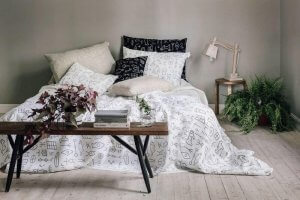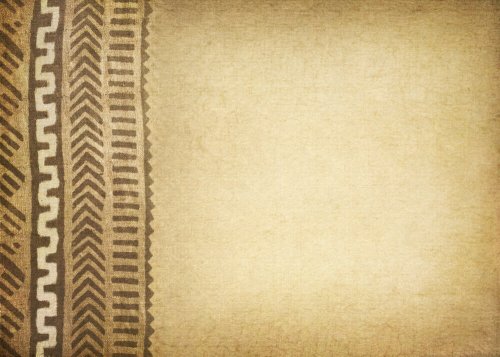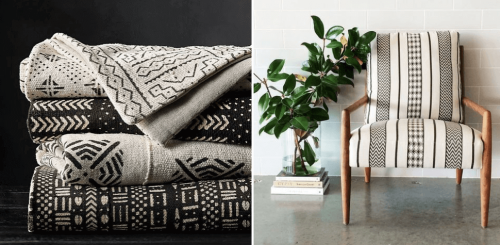Mud Cloth - From Africa to the World

Have you heard about mud cloth? For sure you already know what we’re talking about if you’re up to date with interior design trends. You haven’t? Continue reading then, you’re going to love the story we’re about to tell you. So much so that you won’t be able to resist the urge to use it in every corner of your house.
What exactly is mud cloth?
This is a traditional fabric from Mali. The process it’s made with is quite elaborate and therefore expensive.
As the story goes, the traditional elaboration and secrets of the process go from mothers to daughters and date back to the twelfth century. And the way women do it is by soaking the fabric with a mixture of leaves and tree branches and letting it sun dry for weeks. The fabric acquires a yellowish tone throughout this process.
Then, they draw shapes with a template made of fermented mud. It acquires a grayish hue when it dries and the artisan must wash the fabric again to remove the excess. They then repeat the process several times until the fabric absorbs the pigment and the drawings are well defined. The final product – mud cloth.

If you think the process is rather primitive, let us tell you that each drawing has its meaning and encompasses a whole complex symbolism.
For example, the spiral represents life and the concentric circle the world. Also, there’s a code that only the members of the community can decipher.
Another curious fact is that given this is an artisanal process, there are no two pieces of fabric alike. This is because people make it by hand.
There are industrial processes with which to manufacture it faster and cheaper. Also, its characteristic prints are no longer exclusive of fabrics and you can appreciate them in all sorts of decorative objects.
Keys to decorating with mud cloth

Where?
People have been seduced by African art for several years and it comes in the form of cushions, bedding, carpets, and tapestries with which to adorn your walls.
This is a decorative element that promises a bohemian touch in rustic style homes. Also, the patterns are so simple and minimalistic they easily adapt to any style. It’s very popular in Nordic countries.
Color
As far as color is concerned, the base is usually a two-toned combination such as white and black, browns, mustard tones, blues, and greens, always on top of a tan base.
How
We propose you use mud cloth as an accent for wooden furniture and in combination with other materials such as wool and linen. Also, you might want to add other African details in the area you choose to place it.
Also, you might want to add metal to your decor to create contrast and maximize the effect of this lovely African fabric. The result will be more modern and less boho chic.
Some ideas with mud cloth

You’ll often find these types of prints on carpets, bedding, upholstery, tablecloths, napkins, cushions, and even curtains. However, your imagination has no limits:
- Tableware with this pattern makes for a stylish table setting.
- There are wallpapers available with these motifs and they’re great for the walls of your living room.
- Going back to the fabrics … Have you thought about framing a simple piece of mud cloth? It’s a very original detail with which to liven up at least one of your walls. You can get many interesting combinations by varying the sizes and patterns.
- The technique for making this fabric is complicated. And yet the patterns are so simple you can replicate the two-toned geometric figures and add an African touch to your home.
Does the idea of using this fabric around your home seem exciting? Go for it! Don’t forget to share your creations with us.
https://midecoracion.com/casas/mud-cloth-de-africa-para-el-mundo/
Have you heard about mud cloth? For sure you already know what we’re talking about if you’re up to date with interior design trends. You haven’t? Continue reading then, you’re going to love the story we’re about to tell you. So much so that you won’t be able to resist the urge to use it in every corner of your house.
What exactly is mud cloth?
This is a traditional fabric from Mali. The process it’s made with is quite elaborate and therefore expensive.
As the story goes, the traditional elaboration and secrets of the process go from mothers to daughters and date back to the twelfth century. And the way women do it is by soaking the fabric with a mixture of leaves and tree branches and letting it sun dry for weeks. The fabric acquires a yellowish tone throughout this process.
Then, they draw shapes with a template made of fermented mud. It acquires a grayish hue when it dries and the artisan must wash the fabric again to remove the excess. They then repeat the process several times until the fabric absorbs the pigment and the drawings are well defined. The final product – mud cloth.

If you think the process is rather primitive, let us tell you that each drawing has its meaning and encompasses a whole complex symbolism.
For example, the spiral represents life and the concentric circle the world. Also, there’s a code that only the members of the community can decipher.
Another curious fact is that given this is an artisanal process, there are no two pieces of fabric alike. This is because people make it by hand.
There are industrial processes with which to manufacture it faster and cheaper. Also, its characteristic prints are no longer exclusive of fabrics and you can appreciate them in all sorts of decorative objects.
Keys to decorating with mud cloth

Where?
People have been seduced by African art for several years and it comes in the form of cushions, bedding, carpets, and tapestries with which to adorn your walls.
This is a decorative element that promises a bohemian touch in rustic style homes. Also, the patterns are so simple and minimalistic they easily adapt to any style. It’s very popular in Nordic countries.
Color
As far as color is concerned, the base is usually a two-toned combination such as white and black, browns, mustard tones, blues, and greens, always on top of a tan base.
How
We propose you use mud cloth as an accent for wooden furniture and in combination with other materials such as wool and linen. Also, you might want to add other African details in the area you choose to place it.
Also, you might want to add metal to your decor to create contrast and maximize the effect of this lovely African fabric. The result will be more modern and less boho chic.
Some ideas with mud cloth

You’ll often find these types of prints on carpets, bedding, upholstery, tablecloths, napkins, cushions, and even curtains. However, your imagination has no limits:
- Tableware with this pattern makes for a stylish table setting.
- There are wallpapers available with these motifs and they’re great for the walls of your living room.
- Going back to the fabrics … Have you thought about framing a simple piece of mud cloth? It’s a very original detail with which to liven up at least one of your walls. You can get many interesting combinations by varying the sizes and patterns.
- The technique for making this fabric is complicated. And yet the patterns are so simple you can replicate the two-toned geometric figures and add an African touch to your home.
Does the idea of using this fabric around your home seem exciting? Go for it! Don’t forget to share your creations with us.
https://midecoracion.com/casas/mud-cloth-de-africa-para-el-mundo/







